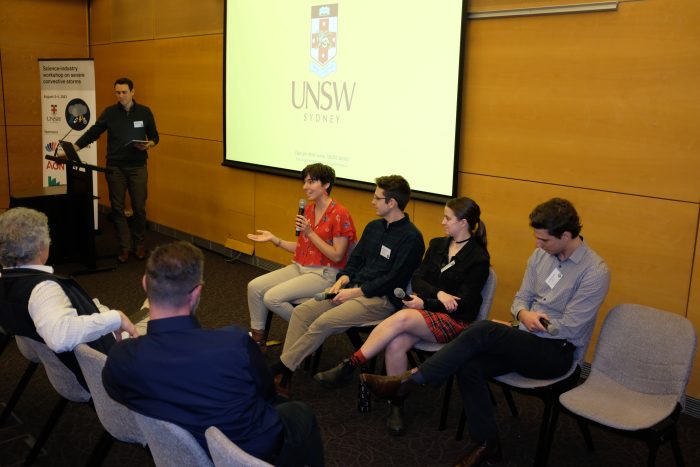Jonathan Brown with Centre researchers.

Extreme storms have played a major role in Australian life in recent years.
Since 2020 alone, severe storms and floods have cost over $12 billion in insurance damage and left many communities with the tough task of rebuilding after disaster.
In a changing climate, it’s more important than ever for decision makers, communities, industries and experts to share knowledge, collaborate and plan for the future.
According to Dr Tim Raupach from the University of New South Wales and the ARC Centre of Excellence for Climate Extremes more can be done to bring severe storm experts together.
“In Australia there is a relatively small – but growing – community working on severe storms research” says Dr Raupach.
“It was apparent that talented people in research and industry were working on severe storm science, yet there is sometimes perceived to be a gulf between these two worlds.”
To address this Dr Raupach collaborated with Dr Joanna Aldridge from insurance company QBE and Dr Joshua Soderholm from the Australian Bureau of Meteorology to bring some of Australia and the world’s severe storm experts together in a 2 day workshop at the University of New South Wales.
Dr Aldridge says the workshop was an opportunity for the insurance industry to learn about new developments in climate science.
“I was very pleased to be involved, as severe convective storms are a key risk for insurers and our customers and a peril that we could understand more about” says Dr Aldrige.
“I was hoping for myself to learn more about the status of the cutting edge of the climate change science for severe convective storms, and the workshop delivered on that. More broadly I was hoping to work towards building a community and industry – academia partnerships to advance our knowledge in future years.”

For Dr Joshua Soderholm the workshop made clear the needs of these expert communities moving forward.
“Both industry and researchers are calling out for more data” says Dr Soderholm.
“We saw some innovative approaches from industry to fill these data gaps and the benefits it delivers. This includes severe weather reports, surface observations of severe weather, insurance claims and emergency services requests.”
The workshop also included contributions from early career researchers, which Dr Soderholm says are vital to the future of the field.
“I’m hoping to see more collaborative investment in early career researchers, from paid internships to multi-year projects. This is an essential step if we’re to train the next generation of scientists needed across industry and research” says Dr Soderholm.
Scientists, industry and communities working together to understand each other’s needs
The workshop included presentations from global leaders in severe storm research, helping Australian experts and industry consider lessons from around the world.
“I got a lot out of our guest speaker Dr Julian Brimelow’s keynote speech on the Northern Hail Project in Canada, which showcased how quality research and fundamental data collection can advance our understanding of this hazard” says Dr Aldridge.
“It was insightful for the Australian research community to see the scale of research being achieved in Canada and what we could consider doing with more investment. It was interesting to see they faced similar challenges in terms of adequacy of the building codes to protect residential housing against storm damage.”

Dr Tim Raupach says the workshop helped him to understand what different stakeholders need from the scientific community.
“I found it very valuable to hear from utility services, the agricultural industry and emergency services – these are sectors who have to deal with storm hazards and impacts on the ground, and it was very informative to hear their experiences, learn from their knowledge and find out exactly what scientific information is most valuable for their work” says Dr Raupach.
The hope of the workshop organisers is that the session closes the “gulf between two worlds” and sets a path for future work together.
“My hope is that the workshop will build momentum and act as a springboard to further collaboration, data sharing, and shared problem solving in severe storm science” says Raupach.
Dr Aldridge agrees.
“We want to get to a point where the research is applied to effect change in how climate risk is managed.”
“Through the research we need to build the body of evidence that can be used to effect change in building codes to make our built environment more resilient to climate change. That is a multidisciplinary effort and requires each of us to step beyond the boundaries of our immediate field to achieve results.”
